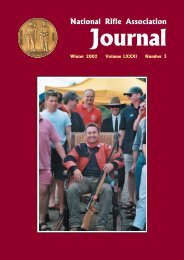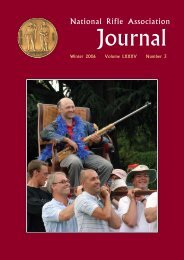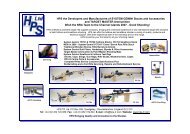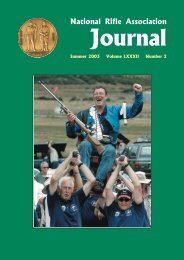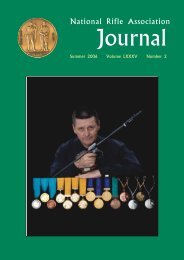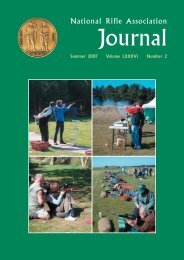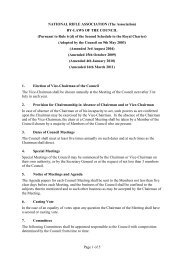NRA Journal - Summer 2004 - National Rifle Association
NRA Journal - Summer 2004 - National Rifle Association
NRA Journal - Summer 2004 - National Rifle Association
- No tags were found...
Create successful ePaper yourself
Turn your PDF publications into a flip-book with our unique Google optimized e-Paper software.
We can see that, compared to the other three, Spencerhas a tendency to occasional wild high and low shots.Charlotte seems to be less prone to this but does nothold as good elevation as Richard and Robert.However, choosing between Richard and Robert, byeyeballing the plots like this, is not so easy.Graphical ComparisonWe can go further now and attempt to see how theseshooters compare in terms of their grouping statistics.The software allows us to calculate 12 differentgrouping statistics• SDH• SDV• SDR• MHD• MVD• ES• EHD• EVD• DIAG• MGR• ASD• CAStandard Deviation in HorizontalDistribution of Backplotted GroupStandard Deviation in VerticalDistribution of Backplotted GroupStandard Deviation in RadialDistribution of Backplotted GroupMean Horizontal DeviationMean Vertical DeviationExtreme Spread Between PairsExtreme Horizontal DispersionExtreme Vertical DispersionDiagonalMean Group RadiusAverage Sighter Distance from MPICone Angle Subtended by CoveringCircleFigure 9 Vertical SD Comparison for four of the CadetsExamining the horizontal curves there is little tochoose between them apart from three particularlyloose shoots by Spencer. The others all sit around aSD of 0.8. However the vertical SD curves are moreseparated and we can see, in particular, that Robert isclearly much more consistent and with a distinctlylower vertical SD than the others.Interestingly, this is not the impression you get fromeyeballing the superposition plots above. Byeyeballing the superposition plots you get theimpression that Richard holds a tighter group thanRobert, but these vertical SD plots show you theopposite.The comparisons for the SD in the horizontal andvertical distribution are shown below; one pointrepresents the statistic for one shoot and curves areshown for the four shooters we are using as anexample:Figure 8 Horizontal SD Comparison for four of the CadetsFrom these SD curves you would say that Richard isalmost as good as Robert but one bad shoot inparticular appears with an SD of 1.74, plus a coupleof cheeky high ones are seen around 0.87.Performance IndicesInvestigating the other indicators graphically isinformative but does not really give us a clear cutcomparison. In order to try to combine these variousgrouping statistics we propose creating combinedindices to see if they can tell us anything. We definetwo indices: the first based on the combined productof the terms, and the second based on the sum of theterms. If we calculate the average of a given indicatorover the set of cards for a given competitor, let us sayfrom the vertical SD curve for Robert above, we canobtain a single number for that grouping statistic forhim. If we do the same for the other 11 statisticsavailable we obtain for each shooter a set of 12numbers which we combine into a product index anda sum index, as defined below.We can use the software to run a comparison betweenselected firers and produce these numbers as shownin figure 10.25





